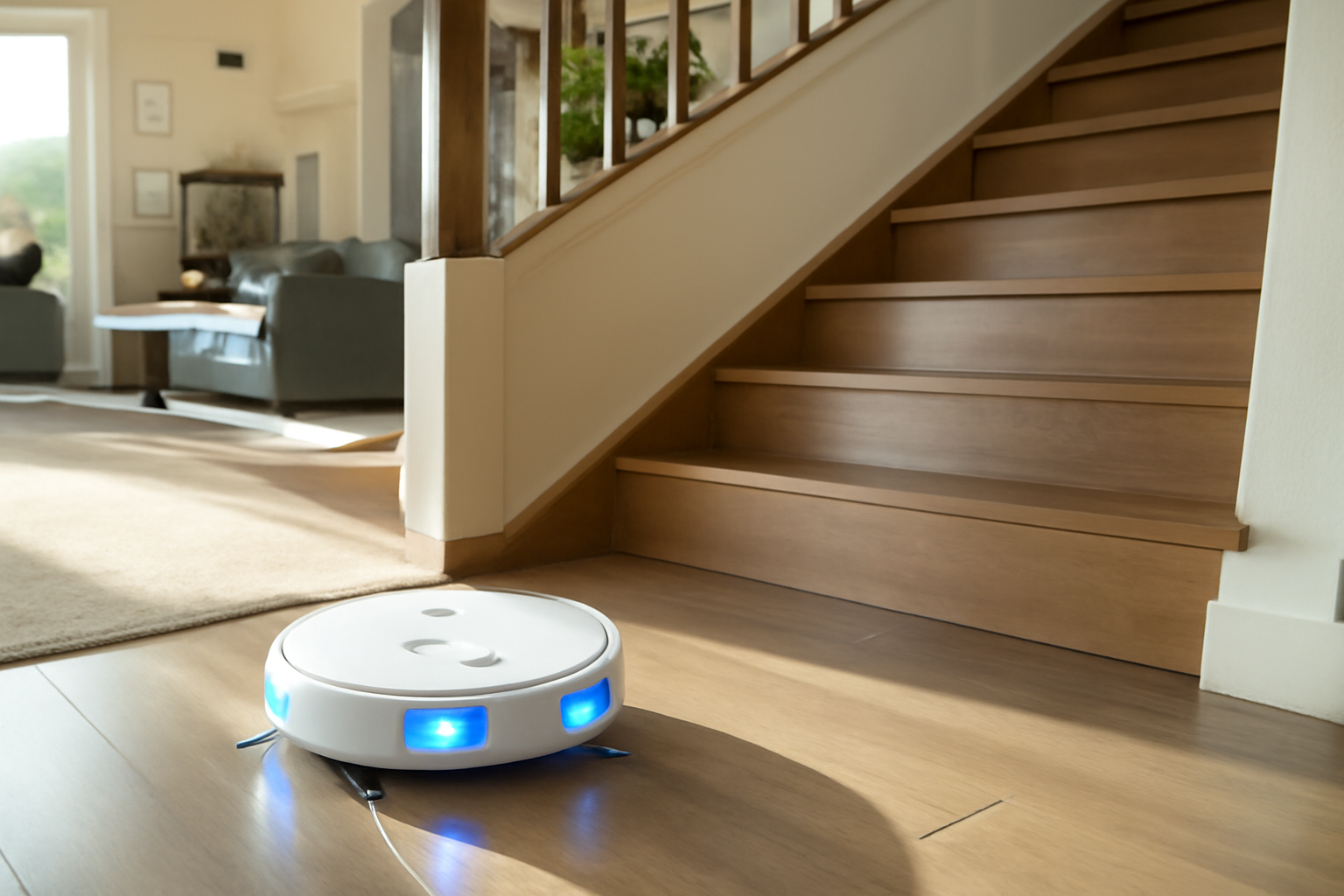
When I first got my hands on a robot vacuum, I was excited about the time it would save me. However, that excitement turned into sheer panic when, during its inaugural run, it almost tumbled down my staircase! This close call ignited my quest to understand how to ensure the safety of robot vacuums. Did you know that cliff sensors, tiny yet mighty, are the unsung heroes preventing these machines from taking a dive?
As I delved deeper, I discovered the importance of these sensors, along with other safety measures, such as virtual walls and physical barriers. Implementing these can significantly enhance your safety game and keep your robot vacuum grounded. I’ve also learned some maintenance tricks and troubleshooting techniques that keep these devices in tip-top shape, ensuring they never take an unintended leap.
**Ensuring your robot vacuum’s safety on stairs involves utilizing cliff sensors, applying preventive measures like physical barriers, and committing to regular maintenance.**
Intrigued about how you can safeguard your gadget? Dive in, and I promise you’ll walk away with insights you can put into action. A well-maintained robot vacuum means not just a cleaner home, but a much safer one too. Give these tips a try—your peace of mind is just a step away!
How can Cliff Sensors prevent robot vacuums from falling down stairs?
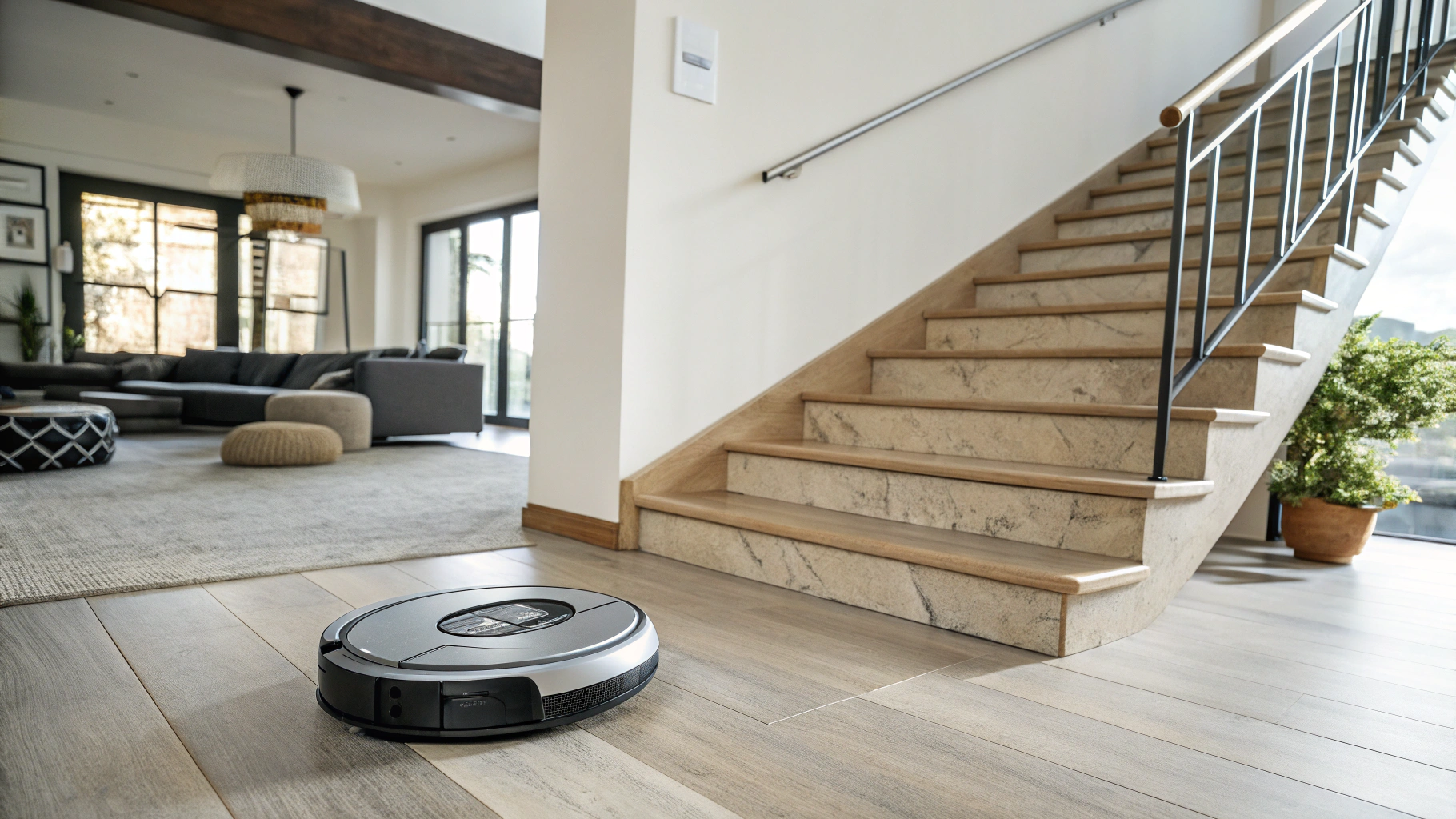
The moment I realized my robot vacuum was on the brink of tumbling down the stairs left me feeling vulnerable and anxious. As someone with a multi-level modern home, I fully understand the importance of cliff sensors. Today, I want to share everything I’ve discovered about these little “guardians” that keep our devices safe.
Initially, I felt helpless regarding the worry of my robot vacuum falling down the stairs. However, after diving deeper into research, I found out that these clever machines are equipped with impressive cliff sensors. Using infrared technology, they can precisely detect height differences, preventing any accidental dives down the stairs. For users like me with dark flooring, it’s also critical to choose the right model, as some sensors respond differently on darker surfaces.
That said, most modern robot vacuum brands are continuously enhancing their technology to ensure greater adaptability and safety. I genuinely hope this information helps you select the most suitable product. If, like me, you’re eager to learn more about the practical applications of this technology or how to maintain these sensors, keep reading. I believe this knowledge will be immensely beneficial in your experience with robot vacuums.
Understanding Cliff Sensors in Robot Vacuums for Enhanced Safety
The realization that my robot vacuum might fall down the stairs was unsettling. However, I discovered that modern devices include advanced cliff sensors utilizing infrared technology, which accurately detect height differences. Especially for those with darker flooring, selecting an appropriate model is crucial since sensor functionality can vary based on surface color. Thus, understanding cliff sensors not only assures safety but also enhances user experience with these handy devices.
| Feature | Description |
|---|---|
| Cliff Sensors | Utilize infrared technology to detect height differences |
| Importance | Prevents robot vacuums from falling down stairs, ensuring safety |
| Surface Sensitivity | Functionality can vary based on floor color, especially with dark floors |
| Modern Advancements | Continuous improvements for greater adaptability and safety |
How infrared technology enhances cliff detection
Infrared technology has dramatically transformed the landscape of cliff detection, heralding an era marked by extraordinary precision and enhanced safety. Harnessing the power of thermal imaging, it discerns minor temperature fluctuations, revealing concealed rockfalls or precarious formations that typically elude human observation. This advanced detection method empowers proactive interventions, thereby safeguarding both hikers and construction teams. Furthermore, the integration of infrared systems with drones offers aerial vantage points that significantly enrich situational awareness. Adopting this cutting-edge approach not only elevates safety standards but also encourages responsible engagement with challenging environments.
Factors influencing sensor performance on various floor types
Grasping the myriad determinants that impact sensor efficacy across diverse flooring types is essential for maximizing implementation effectiveness. Each surface—be it hardwood, tile, or carpet—poses unique obstacles. Variations in friction, elasticity, and thermal characteristics contribute significantly to sensor precision and responsiveness. Moreover, ambient conditions such as humidity and temperature can skew data interpretations. Meticulously selecting a sensor tailored to the flooring type not only ensures data reliability but also amplifies system efficiency. Acquiring knowledge about these factors facilitates judicious choices in sensor applications.
Recent advancements in robot vacuum safety technology
Recent innovations in robotic vacuum safety protocols have fundamentally transformed domestic cleaning practices. Enhanced sensor technologies now adeptly identify obstacles, deftly circumventing dangers such as staircases and beloved pets, thus ensuring uninterrupted functionality. Additionally, advanced algorithms facilitate astute navigation, substantially reducing the likelihood of entrapment or inadvertent damage. By embedding formidable safety mechanisms, producers are not merely optimizing performance but are also fostering tranquility for users. Consequently, robotic vacuums are emerging as essential partners in the pursuit of a pristine and secure habitation.
What practical tips exist to keep robot vacuums safe from stairs?
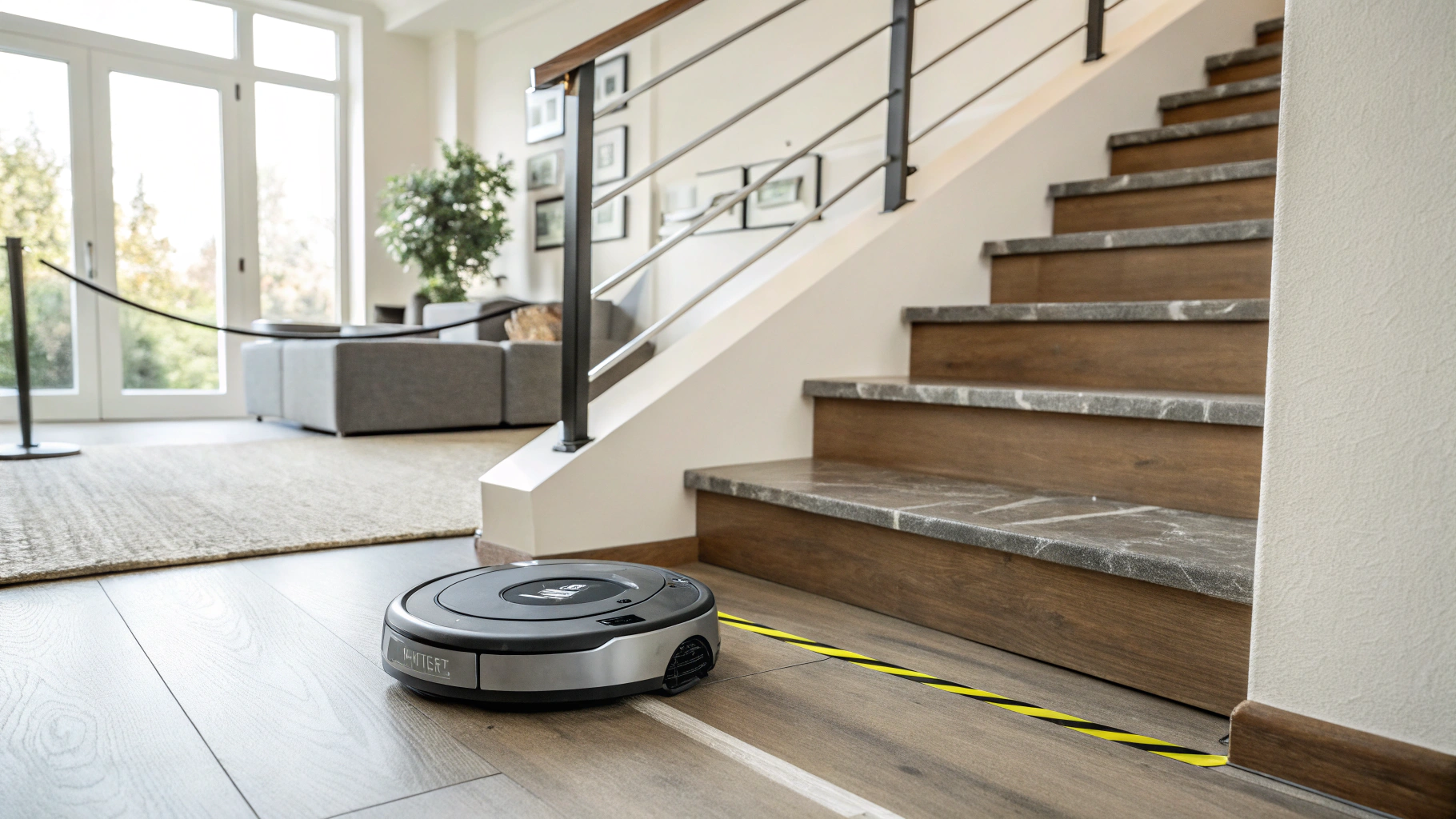
When I first encountered the idea of owning a robotic vacuum cleaner, I found myself torn between excitement and anxiety. The convenience was undeniable, but the prospect of it plummeting down my staircase filled me with dread. That moment spurred me into action, and I embarked on a quest to ensure my robotic vacuum cleaner’s safety in my multi-level home.
By diving deep into the world of robotic vacuum safety features, I discovered how critical elements like cliff sensors could be. I still remember my sense of relief when I realized that maintaining these sensors with regular cleaning could significantly reduce the risk of falls. Along the way, I learned that keeping the software updated was equally essential, as manufacturers frequently rolled out improvements that enhanced performance and responsiveness.
Implementing physical barriers like boundary strips was another game-changer for me. It was fascinating to see how these simple tools created effective invisible walls, steering my vacuum clear of danger. Additionally, training my device to navigate my home layout really boosted its efficiency, especially in challenging areas.
In essence, ensuring the safety of a robotic vacuum cleaner involves understanding and maintaining its features while using strategic barriers. My journey has shown me that with a little foresight, keeping my robotic helper safe is entirely achievable. I truly hope these tips empower you to embrace the convenience of robotic cleaning without worry!
Ensuring Safety in Robotic Vacuum Cleaners: Essential Tips
Imagine the peace of mind knowing your robotic vacuum cleaner can safely navigate your multi-level home. My journey into robotic vacuum safety revealed that features like cliff sensors and regular software updates are crucial for performance. Implementing physical barriers, such as boundary strips, can create effective invisible walls, ensuring safety. With attention to these details, embracing the convenience of robotic cleaning becomes worry-free.
| Safety Feature | Description | Maintenance Tips |
|---|---|---|
| Cliff Sensors | Prevents falls from stairs and ledges. | Regularly clean and check functionality. |
| Software Updates | Enhances performance and responsiveness. | Keep firmware up to date. |
| Boundary Strips | Creates invisible walls to prevent access to dangerous areas. | Place strips strategically around risky zones. |
| Navigation Training | Improves efficiency in challenging layouts. | Regularly map and adapt to your home’s layout. |
Importance of cliff sensors in preventing falls
Cliff sensors are indispensable allies in the realm of fall prevention, particularly within the bustling landscapes of construction sites and outdoor venues. These advanced apparatuses adeptly sense elevation shifts, initiating swift actions to mitigate the threat of catastrophic mishaps. By weaving cliff sensors into their safety regimes, organizations not only protect their workforce but also diminish the risk of injuries considerably. Furthermore, this embrace of innovation fosters a proactive ethos centered around awareness and safety—an essential investment for progressive firms committed to prioritizing the well-being of their employees.
Regular maintenance for optimal sensor performance
Consistent upkeep is paramount for ensuring sensors deliver peak performance. As time progresses, various environmental elements can compromise sensor precision, yielding inaccurate data. By adhering to a regimen of inspections and calibrations, one guarantees that sensors function within designated thresholds. Routine cleaning and replacing aged components bolster both durability and dependability. Furthermore, an anticipatory maintenance schedule diminishes downtime while amplifying operational efficacy. Committing to this proactive approach fortifies data integrity, thereby facilitating enlightened decision-making and superior results.
Utilizing boundary strips as an effective safety measure
Boundary strips emerge as a vital safety mechanism across diverse settings, delineating secure perimeters that mitigate accidents while amplifying visibility. In bustling work environments, these strips adeptly instruct personnel to comply with established safety protocols. Their vivid hues and reflective properties captivate attention, fostering respect for safety boundaries. Adopting boundary strips transcends mere vigilance; it represents a forward-thinking initiative aimed at cultivating a safer workplace for all involved. Embrace safety as a priority today!
Why do some robot vacuums still fall down stairs?
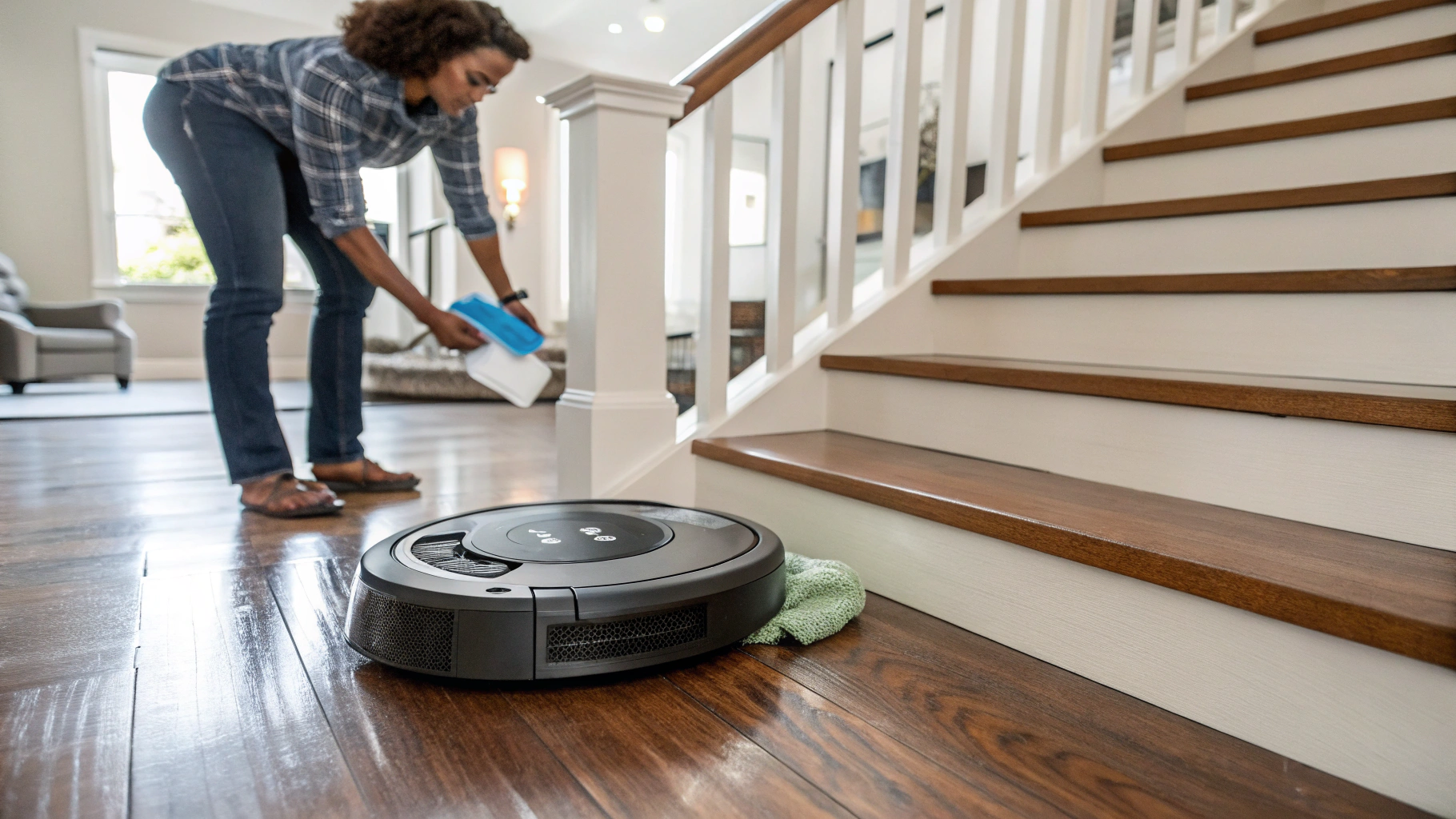
When I first discovered my robot vacuum cleaner tumbling down the stairs during its cleaning routine, I felt utterly confused and concerned. Despite being equipped with advanced anti-fall technology, it was clear that this wasn’t foolproof. This prompted me to dig deeper into the issue, not just for my own sake but for friends grappling with the same frustrating problem. Through my research, I learned several key reasons for these mishaps, such as how the cliff sensors could fail due to varied floor materials and, sometimes, even simple sensor issues, like dust accumulation.
To prevent my vacuum from continuing its risky “adventures,” I started focusing on how to effectively maintain these sensors and examined the technical differences among various brands. I discovered that keeping the sensors clean and possibly upgrading the anti-fall features is crucial. Additionally, selecting appropriate protective accessories can make a significant difference. I hope my experience offers valuable insights that help you tackle similar challenges.
If your robot vacuum cleaner is also facing such issues, give these tips a try. I’m confident you’ll see improvements!
Understanding Robot Vacuum Cleaners’ Anti-Fall Challenges
Have you ever experienced your robot vacuum tumbling down the stairs despite its advanced sensors? This common issue stems from sensor malfunctions or environmental factors. My research revealed that keeping sensors clean and choosing the right protective accessories can significantly enhance performance. Implementing these maintenance tips can prevent your vacuum from risky falls and improve its efficiency.
| Issue | Cause | Solution |
|---|---|---|
| Falling down stairs | Cliff sensor failure | Regular sensor cleaning |
| Poor performance | Dust accumulation | Upgrade anti-fall features |
| Inconsistent cleaning | Floor material differences | Select protective accessories |
Common sensor failures leading to falls
Falls represent a significant concern across multiple environments, frequently emerging from typical sensor malfunctions. For example, a misbehaving motion sensor can misconstrue the surrounding data, yielding procrastinated reactions within safety mechanisms. Likewise, unreliable pressure sensors might inaccurately gauge human presence, jeopardizing alert systems. Furthermore, improper calibration can lead to erroneous alerts—both false positives and negatives—eroding confidence in these essential technologies. By rectifying such deficiencies, we can bolster safety measures and substantially diminish fall hazards.
Impact of floor material on cliff detection
In the exploration of floor materials’ influence on cliff detection, the subtleties of technological harmonization become apparent. Sophisticated sensors are intricately attuned to surface traits, which are pivotal for coherent terrain mapping. For instance, concrete’s unique signal reflection capabilities diverge from those of organic materials, thereby impacting the efficacy of detection operations. When faced with varied environmental contexts, the strategic selection of flooring materials critically refines cliff detection algorithms, promoting accurate topographical evaluations. Grasping these dynamics is vital for augmenting navigational security in treacherous terrains, ultimately facilitating superior decision-making in sectors reliant on precise terrain interpretation.
Maintenance tips for optimal anti-fall performance
To guarantee peak anti-fall efficacy, consistent maintenance is imperative. Initiate by scrutinizing safety apparatus for signs of deterioration; promptly substitute any impaired elements. Furthermore, ascertain that installation zones are devoid of obstructions that may jeopardize fall prevention mechanisms. Enlighten personnel on correct usage protocols and facilitate regular training to instill optimal practices. Additionally, maintain an exhaustive log of inspections to monitor maintenance activities. Diligent care not only fortifies safety but also amplifies system reliability, thereby diligently protecting your workforce.
How can regular maintenance help in avoiding stair accidents?

As a property owner, I’ve often found myself pondering the complexities of maintaining a commercial building. One particular challenge that initially caught me off guard was stair safety. However, after witnessing a near accident, the importance of regular stair maintenance became crystal clear for me. It’s incredible how something as routine as stair upkeep can prevent serious accidents, elevate safety standards, and significantly reduce liability risks.
I made the decision to invest in non-slip materials and created a handrail inspection checklist, and I’ve discovered that details matter immensely. Understanding common causes of stair accidents and implementing effective safety tips have been invaluable in minimizing risks. Whether you’re managing a facility or handling insurance assessments, applying these stair safety strategies can transform your property management practices.
If you’re committed to improving your building’s safety standards, I recommend adopting a comprehensive maintenance approach. Explore the latest innovations in stair materials and technologies, and follow a proactive maintenance plan. Try these strategies, and I believe you’ll experience the same uplifting results I have—enhanced safety and peace of mind. Maintaining stairs regularly is crucial for accident prevention, as it enhances safety and reduces liabilities for property owners, making it a vital aspect of commercial property management.
Enhancing Stair Safety: Essential Maintenance Strategies for Property Owners
Have you ever considered the critical role of regular stair maintenance in commercial buildings? I learned the hard way that it significantly enhances safety and reduces liability risks. By investing in non-slip materials and adopting a handrail inspection checklist, I minimized risks dramatically. Implementing these proactive strategies ensures peace of mind for property managers, making stair safety a crucial aspect of maintaining any commercial property.
| Strategy | Description |
|---|---|
| Non-Slip Materials | Investment in non-slip surfaces to prevent accidents. |
| Handrail Inspection | Regular checks to ensure handrails are secure and effective. |
| Proactive Maintenance | Follow a preventive maintenance schedule for stair upkeep. |
| Education | Understanding common causes of stair accidents to mitigate risks. |
Importance of regular stair inspections for safety
The indispensable act of routinely inspecting stairways cannot be overstated when it comes to maintaining safety standards within any edifice. Such evaluations meticulously unveil deterioration, structural frailties, or unforeseen dangers that might precipitate unfortunate incidents. By embracing consistent scrutiny, property overseers not only adhere to safety mandates but simultaneously mitigate potential liability. Prompt maintenance arising from inspection insights fortifies user trust, assuring that stairways continue to be both inviting and safe conduits within your establishment. Elevate stairwell safety as a priority!
Effective materials to enhance stair traction
Ensuring safety on stairways is critical; thus, it is vital to utilize effective materials that bolster traction. Think of anti-slip coatings, which cloak surfaces in an unobtrusive yet protective layer, harmonizing function with aesthetics. Alternatively, textured vinyl or rubber treads present a compelling option due to their robustness and grip. Furthermore, pioneering materials, such as nanotechnology-enhanced surfaces, are on the rise, promising unrivaled traction. By investing in these innovations, you not only reduce slip hazards but also cultivate a secure space for everyone. Prioritize safety; elevate your stair traction now.
Proactive maintenance strategies to minimize accident risks
Proactive maintenance methodologies are indispensable for curtailing accident hazards across various sectors. By integrating routine assessments with cutting-edge predictive analytics, organizations can pinpoint latent threats prior to their proliferation. Fostering a safety-centric ethos amplifies employee vigilance, facilitating prompt detection of equipment anomalies. Furthermore, the integration of avant-garde technologies such as IoT sensors enables real-time assessment of machinery integrity, promoting timely corrective actions. Ultimately, these approaches engender a more secure workplace, enhancing operational efficacy while mitigating costs associated with accidents.
What role do advanced technologies play in improving safety?
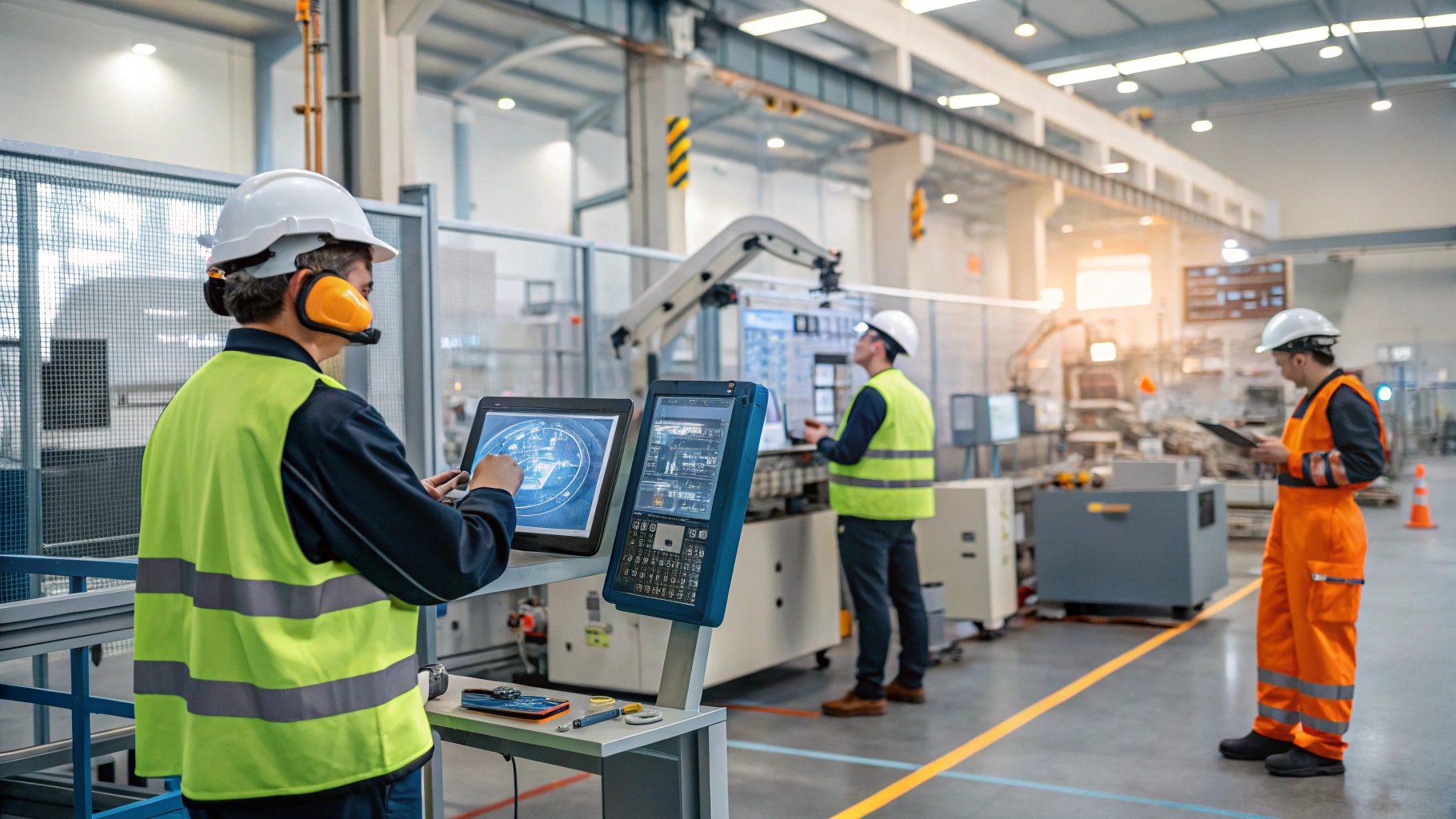
When I first encountered the bewildering labyrinth of safety protocols in the manufacturing sector, I often found myself wondering, “Is there an easier way to ensure everyone’s safety?” That’s when I discovered the transformative impact of advanced technologies on workplace safety. Today, I’m excited to share insights from my journey through the integration of cutting-edge tools like AI safety monitoring systems and smart PPE, which have completely revolutionized our approach to safety.
Imagine AI-powered systems vigilantly scanning the workplace, identifying potential hazards before they could become imminent threats. The power of smart PPE, which provides real-time health monitoring to preempt accidents, is not just a futuristic dream; it’s a reality that Industry 4.0 has brought into our safety practices.
In my experience, using VR/AR for safety training has ushered in a new era of learning, transforming traditional methods into immersive experiences. By leveraging remote hazard detection and safety data analytics, we’re not just reacting to safety issues anymore; we’re proactively preventing them.
If you’re intrigued by how digital transformation is reshaping workplace safety and eager to explore the evolving trends, join me as we dive deep into these technologies. Together, we’ll uncover how these innovations can create safer environments and provide significant business value. Embrace these concepts, and you’ll witness a safer, more efficient workplace unfold before your eyes.
Transforming Workplace Safety with Advanced Technologies
Have you ever imagined a workplace where safety is preemptively managed? Advanced technologies like AI safety monitoring and smart PPE are reshaping how we ensure worker safety. By employing these innovations, we can proactively identify hazards and enhance health monitoring, making accidents a thing of the past. This digital transformation is not just a trend but a vital strategy for creating safer environments and delivering tangible business benefits.
| Technology | Impact on Safety |
|---|---|
| AI Safety Monitoring | Identifies potential hazards in real-time |
| Smart PPE | Provides real-time health monitoring |
| VR/AR for Training | Transforms traditional safety training into immersive experiences |
| Remote Hazard Detection | Proactively detects risks before they escalate |
| Safety Data Analytics | Enhances decision-making through data-driven insights |
The impact of AI safety monitoring systems in workplaces
In the dynamic realm of contemporary work environments, the assimilation of AI-driven safety monitoring frameworks markedly amplifies operational efficiency. These sophisticated systems not only facilitate real-time oversight but also scrupulously scrutinize data to anticipate impending risks. By harnessing the power of predictive analytics, enterprises can proactively mitigate safety issues, cultivating an ethos of preemptive risk management. Furthermore, the deployment of AI technologies refines compliance mechanisms, assuring conformity with rigorous regulatory demands. In essence, AI safety monitoring is not merely transforming workplace security but also enhancing overall organizational effectiveness.
How smart PPE is enhancing real-time health monitoring
Smart Personal Protective Equipment (PPE) is heralding a new era in real-time health surveillance by intertwining cutting-edge technologies such as IoT sensors and AI-driven analytics. Such advancements enable healthcare providers to effortlessly monitor vital signs alongside environmental variables. By facilitating instantaneous data transmission, potential anomalies are swiftly identified, paving the way for timely interventions. As industries embrace a data-centric approach, the fusion of intelligent PPE with health monitoring systems signifies a transformative leap—amplifying safety and optimizing outcomes. Step into this evolution to protect today’s workforce.
The role of VR/AR in revolutionizing safety training methods
In the ever-evolving landscape of workplace safety, immersive VR and AR technologies are dramatically transforming training paradigms. Envision slipping on a VR headset, seamlessly traversing perilous environments while adeptly identifying latent hazards. Conversely, augmented reality superimposes vital instructions onto tangible experiences, facilitating instantaneous understanding. These cutting-edge approaches not only curtail training duration but also amplify participant engagement and effectiveness. Dive into the future of safety training—harness the extraordinary potential of VR and AR today!
Conclusion
In conclusion, understanding and implementing the crucial features of robot vacuums, such as cliff sensors, can significantly enhance user safety. This article has shed light on various protective measures, including the importance of regular maintenance and the effective use of physical barriers, like boundary strips, which collectively contribute to a worry-free cleaning experience. By paying attention to these elements, you can ensure your robot vacuum operates at its best while minimizing the risk of accidents.
As you look to embrace the convenience of robotic cleaning, consider investing in models that boast advanced safety features and commit to maintaining them regularly for optimal performance. Moreover, integrating supplementary safety protocols can elevate your experience further. Remember, a well-cared-for robot vacuum not only guarantees a cleaner home but also fosters peace of mind as you navigate multi-level living spaces.

